The Coral Reefs of Agatti Island – IELTS Reading Answers
6 min read
Updated On
-
Copy link
Table of Contents

Limited-Time Offer : Access a FREE 10-Day IELTS Study Plan!
The Academic passage ‘The Coral Reefs of Agatti Island’ is a reading passage that appeared in an IELTS Test.
It contains some of the IELTS reading question types. If you are interested in familiarising yourself with all the question types, don’t hesitate to take an IELTS reading practice test.
The Coral Reefs of Agatti Island
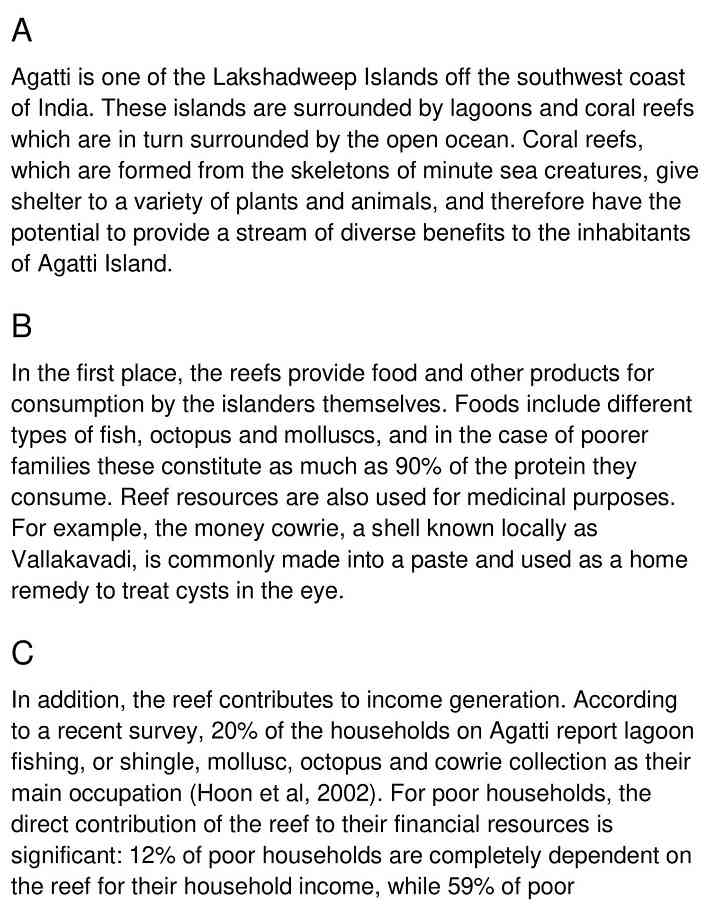

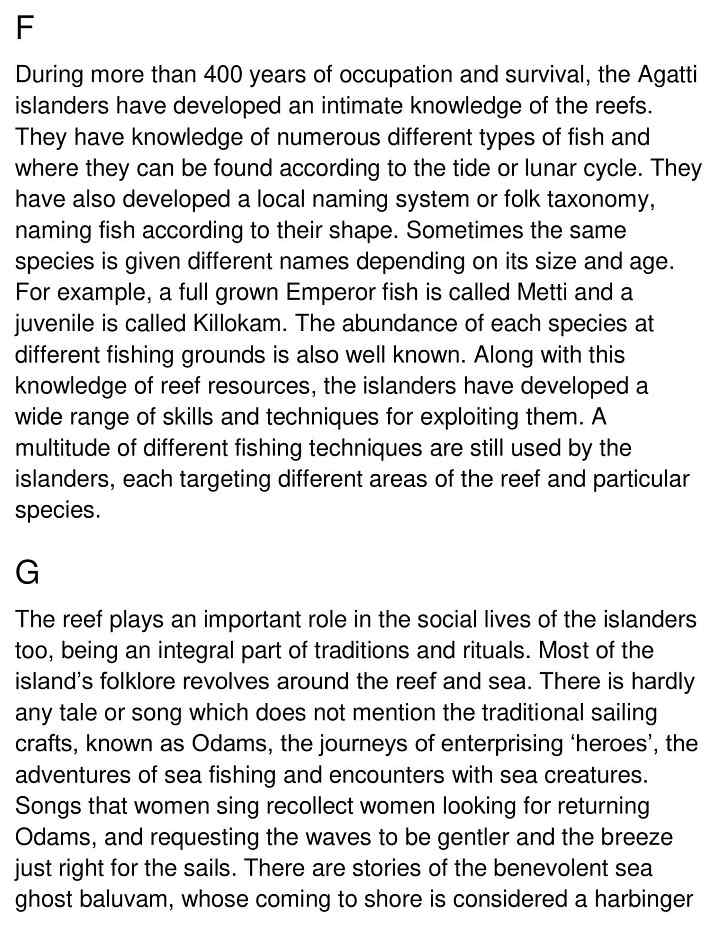

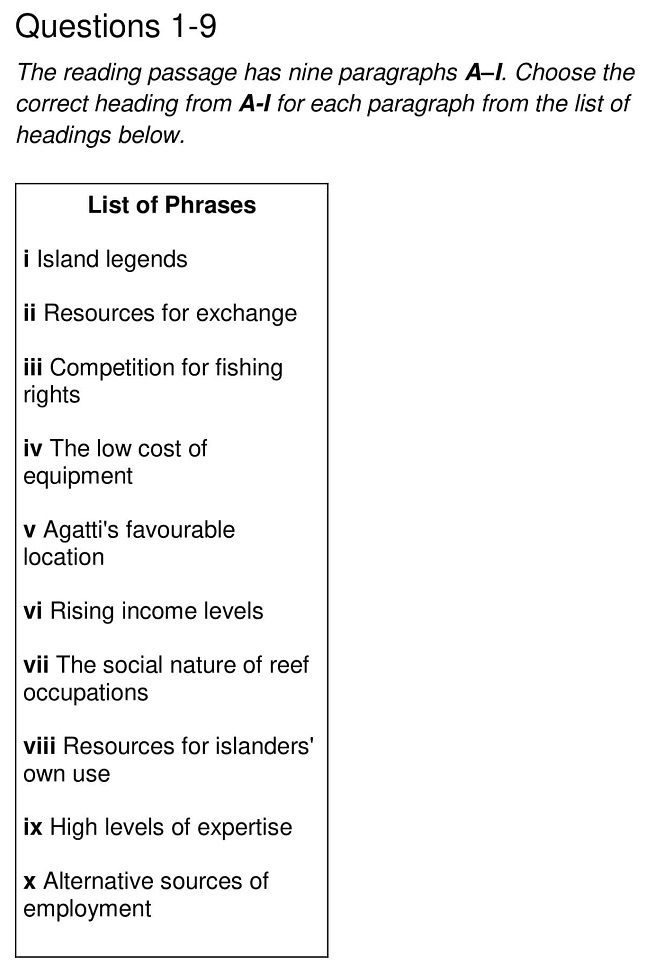
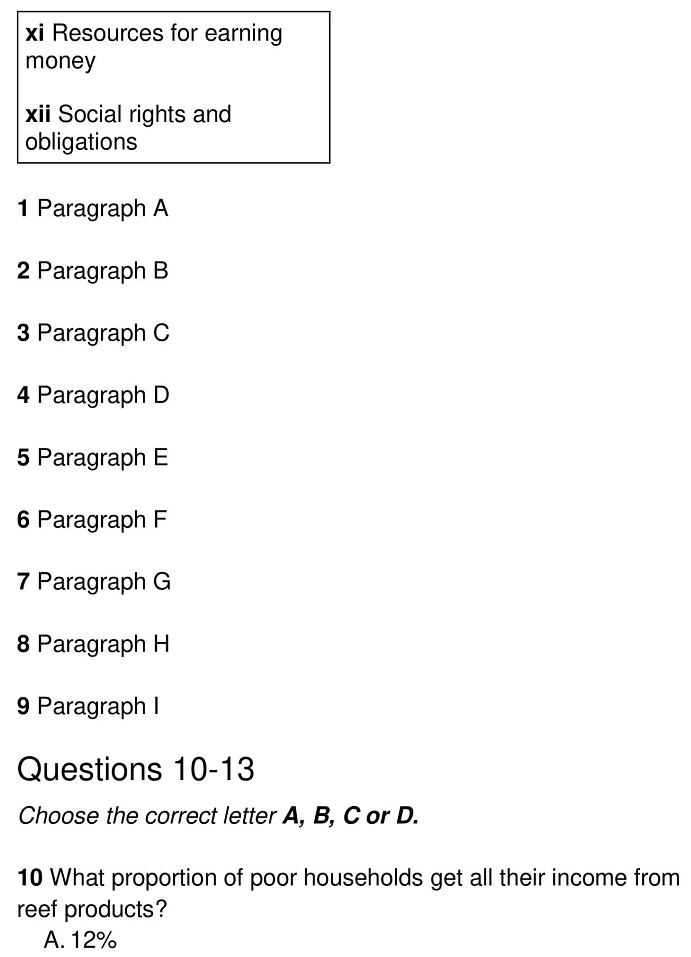

Answers
Unlock Answers
| Question number | Answer | Explanation |
|---|---|---|
| 1 | v | Paragraph A makes it known that Agatti is surrounded by lagoons and coral reefs which are in turn surrounded by the open ocean. This makes the location of the island is favourable. Hence, the answer is v (Agatti’s favourable location). |
| 2 | viii | Paragraph B states that the reefs provide food and other products for consumption by the islanders themselves. Foods include different types of fish, octopus and molluscs which constitute as much as 90% of the protein they consume. Reef resources are also used for medicinal purposes. For example, the money cowrie, a shell known locally as Vallakavadi, is commonly made into a paste and used as a home remedy to treat cysts in the eye. Therefore, different resources that the islanders get from the coral reef are discussed. Hence, the answer is viii (Resources for islanders’ own use). |
| 3 | xi | Paragraph C informs that the reef contributes to income generation. 20% of the households on Agatti report lagoon fishing, or shingle, mollusc, octopus and cowrie collection as their main occupation. For poor households, the direct contribution of the reef to their financial resources is significant: 12% of poor households are completely dependent on the reef for their household income, while 59% of poor households rely on the reef for 70% of their household income, and the remaining 29% for 50% of their household income. So, this paragraph is about the resources of the islanders to earn their livelihood. Hence, the answer is xi (Resources for earning money). |
| 4 | ii | Paragraph D mentions that bartering of reef resources also commonly takes place, both between islanders and between islands. For example, Agatti Island is known for its abundance of octopus, and this is often used to obtain products from nearby Androth Island. Locally, reef products may be given by islanders in return for favours, such as help in constructing a house or net mending, or for other products such as rice, coconuts or fish. Therefore the exchange of resources from the coral reef takes place between the islanders as well as the islands. Hence, the answer is ii (Resources for exchange). |
| 5 | iv | Paragraph E explains that the investment required to exploit the reefs is minimal. It involves simple, locally available tools and equipment, some of which can be used without a boat, such as the fishing practice known as Kat moodsal. A small cast net, a leaf bag, and plastic slippers are all that are required, and the activity can yield 10–12 small fish (approximately 1 kg) for household consumption. Cast nets are not expensive, and all the households in Agatti own at least one. Even the boats, which operate in the lagoon and near-shore reef, are constructed locally and have low running costs. So, with the use of locally made, cost effective equipment the islanders catch fishes and earn. Hence, the answer is iv (The low cost of equipment). |
| 6 | ix | Paragraph F tells us that during more than 400 years of occupation and survival, the Agatti islanders have developed an intimate knowledge of the reefs. They have knowledge of numerous different types of fish and where they can be found according to the tide or lunar cycle. They have also developed a local naming system or folk taxonomy, naming fish according to their shape. Along with this knowledge of reef resources, the islanders have developed a wide range of skills and techniques for exploiting them. A multitude of different fishing techniques are still used by the islanders, each targeting different areas of the reef and particular species. Therefore, the islanders have gained a high level of expertise related to the fishes. Hence, the answer is ix (High levels of expertise). |
| 7 | i | Paragraph G points out that the reef plays an important role in the social lives of the islanders as it is an integral part of traditions and rituals. Most of the island’s folklore revolves around the reef and sea. There is hardly any tale or song which does not mention the traditional sailing crafts, the journeys of enterprising ‘heroes’, the adventures of sea fishing and encounters with sea creatures. There are stories of the benevolent sea ghost whose coming to shore is considered a harbinger of prosperity for that year, bringing more coconuts, more fish and general well-being. So, this paragraph deals with the legends of the island in forms of songs and stories. Hence, the answer is i (Island legends). |
| 8 | xii | Paragraph H communicates that the reef is regarded by the islanders as common property, and all the islanders are entitled to use the lagoon and reef resources. In the past, fishing groups would obtain permission from the Amin (island head person) and go fishing in the grounds allotted by him. On their return, the Amin would be given a share of the catch. This practice no longer exists, but there is still a code of conduct or etiquette for exploiting the reef, and common respect for this is an effective way of avoiding conflict or disputes. So, the islanders maintain social rights and follow obligations, some of which are discussed in this paragraph. Hence, the answer is xii (Social rights and obligations). |
| 9 | vii | Paragraph I bring out the fact that exploitation of such vast and diverse resources as the reefs and lagoon surrounding the island has encouraged collaborative efforts, mainly for purposes of safety, but also as a necessity in the operation of many fishing techniques. For example, an indigenous gear and operation known as Bala fadal involves 25–30 men. Reef gleaning for cowrie collection by women is also a common activity, and even today, although its economic significance is marginal, it continues as a recreational activity. So, the activities undertaken involving the reefs are not only economic but are also meant for recreation.
Hence, the answer is vii (The social nature of reef occupations). |
| 10 | A | Paragraph C specifies that 12% of poor households are completely dependent (get all their income) on the reef for their household income. Hence, the answer is A (12%). |
| 11 | C | Paragraph E describes that the investment required to exploit the reefs is minimal (little investment). Fishing practices like Kat moodsal involves simple, locally available tools and equipment and can be used without a boat. The practice is usually carried out using a small cast net, a leaf bag, and plastic slippers. Cast nets are not expensive and even the boats are constructed locally and have low running costs. Hence, the answer is C (requires little investment). |
| 12 | B | Paragraph F indicates that during more than 400 years of occupation and survival, the Agatti islanders have developed an intimate knowledge of the reefs. They have knowledge of numerous different types of fish and where they can be found according to the tide or lunar cycle. They have also developed a local naming system or folk taxonomy, naming fish according to their shape. Along with this knowledge of reef resources, the islanders have developed a wide range of skills and techniques for exploiting them. A multitude of different fishing techniques are still used by the islanders, each targeting different areas of the reef and particular species. So, the writers describe the fishing expertise of present-day islanders. Hence, the answer is B (fishing expertise). |
| 13 | D | Paragraph H refers to the fact that the reef is regarded by the islanders as common property, and all the islanders are entitled to use the lagoon and reef resources. Earlier, there was a system of taking permission from the Amin (island head person) and go fishing in the grounds allotted by him. But this practice no longer exists, and there is open access to the reef on Agatti. Hence, the answer is D (There is open access). |
Check More IELTS Reading Answers
Also check :
Practice IELTS Reading based on question types

Start Preparing for IELTS: Get Your 10-Day Study Plan Today!
Recent Articles

Nehasri Ravishenbagam

Haniya Yashfeen

Haniya Yashfeen

Haniya Yashfeen
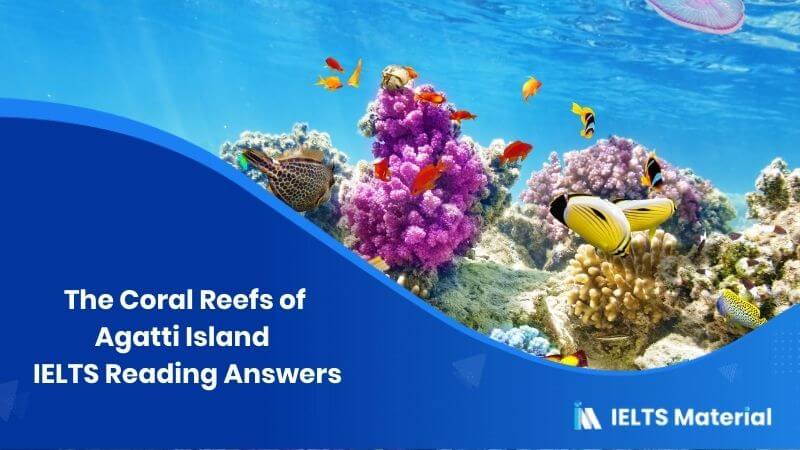



Post your Comments